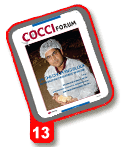Cocci News
New web site focuses on NE, other intestinal health topics
Looking for the latest information about managing
clinical and subclinical necrotic enteritis (NE)?
Check the new web site developed by
Schering-Plough Animal Health to support its
new Clostridium perfringens type A toxoid:
www.netvaxforpoultry.com.
Besides providing technical information about
the industry's first NE vaccine, the site features a
vast menu of articles, FAQs, presentations and
podcasts that address the challenges of managing
NE in antibiotic-free production.
Knowing that NE is linked to other intestinal
health problems, the site's creators included special
sections on coccidiosis, gangrenous dermatitis,
nutrition, antibiotic resistance and other related
topics.
Field trial results with new NE toxoid detailed in technical services bulletins
The results of field trials with the new Clostridium perfringens
type A toxoid for control of necrotic enteritis (NE) in
broilers are detailed in two new technical service bulletins
from Schering-Plough Animal Health.
"Clostridium perfringens Type A Toxoid: Field Efficacy
Without Sub-Therapeutic Antibiotics. Part I: Coccidiosis
Vaccine Trials" is about the use of the new NE vaccine
by a commercial, antibiotic-free broiler integrator.
The NE vaccine was
administered to
breeder pullets,
which convey
immunity against
C. perfringens -
the cause of NE -
to their broiler progeny.
The only protection
against coccidiosis
that all broilers in
the trial had was the
Coccivac-B vaccine. The
trial results show that the
NE vaccine provided significant
protection against
C. perfringens in antibioticfree
broilers.
In fact, broilers from hens
that had not received the NE
toxoid had 47% higher odds
for mortality between 22 and
28 days compared to broilers from hens that received the NE
toxoid. The odds for mortality during cold weather were an
astounding 73% higher during the same time period in broilers
without maternal protection against the alpha toxin.
Both the odds ratio and the relative risk compare the relative
likelihood of an event occurring between two distinct
groups. The relative risk is easier to interpret and consistent
with the general intuition, but some designs prevent the calculation
of the relative risk. In addition, there is
some ambiguity about
which relative risk is
being compared.
When reading
research that summarizes
data using odds
ratios or relative risks,
the limitations of these
measures needs to be
considered.
The second new
bulletin is entitled
"Clostridium perfringens
Type A Toxoid:
Field Efficacy in Broiler
Flocks Without
Subtherapeutic
Antibiotics. Part II:
Ionophore Trials." These
trials were conducted at
farms where NE had been
a sporadic problem.
Broilers from hens that received the NE toxoid demonstrated
statistically significant improvements in livability,
feed conversion, calorie conversion, adjusted calorie conversion
and standard cost compared to broilers from hens that
did not receive the NE vaccine.
Informative booklet answers questions about new necrotic enteritis vaccine
An informative, 18-page booklet answers virtually everything producers and veterinarians
may want to know about the new clostridial toxoid vaccine for control of
necrotic enteritis (NE) in poultry.
Clostridium perfringens type A toxoid, the first vaccine for necrotic enteritis in
poultry, is currently being used in the United States under a conditional license.
The booklet about the vaccine is printed in an easy-to-read question and answer
format. It provides a vast array of information including descriptions of the vaccine,
how it works, as well as results from field trials that evaluated the efficacy
and safety of the product.
Readers will learn how the vaccine can benefit antibiotic-free flocks and conventional
flocks receiving ionophores or antibiotic growth promoters.
Information on the cost-effectiveness of the vaccine is provided.
In addition, the booklet contains important information on necrotic enteritis
and the economic consequences of the disease.
Interactive calculator determines value of new toxoid for necrotic enteritis
An interactive online calculator has been designed to help
individual poultry operations determine their return on
investment when they use the new Clostridium perfringens
type A toxoid for control of necrotic enteritis (NE) in broilers.
The NE vaccine is administered to hens, which pass on
immunity against C. perfringens to their broiler progeny.
Users simply punch in their own production numbers -
things like vaccine cost per pullet, the labor cost per pullet,
the number of eggs per hen, the average hatchability rate
and the average live weight, number of broilers placed per
week "and the calculator computes the anticipated weekly
and annual return.
Marcelo Lang, poultry marketing director for Schering-
Plough Animal Health, says the cost of subclinical NE alone
has been estimated to be about US $0.05 per bird, which far
exceeds the investment in vaccinating
breeder flocks with Clostridium perfringens
type A toxoid.
One 500 mL bottle of the NE vaccine
treats 500 pullets on a two-shot treatment
schedule. If it is assumed that
each hen will produce 156 fertile eggs
"a common industry average "with
an average hatchability rate of 84% or
131 chicks per hen, the cost of the vaccine
is estimated to be about $0.003 or a
quarter of a penny per broiler chick.
At three large-bird complexes involving
more than 26 million broilers, use of
the NE vaccine resulted in improved livability
and reduced production costs,
yielding a return on investment determined
to be 8:1, he says.
However, "Each poultry operation is
going to have different factors affecting
costs and outcome. The calculator will
help determine the vaccine's value for individual operations,"
Lang says.







